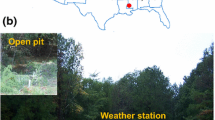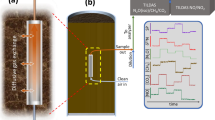Abstract
A multi-channel, steady-state flow-through (SSFT), soil-CO2 flux monitoring system was modified to include a larger-diameter vent tube and an array of inexpensive pyroelectric non-dispersive infrared detectors for full-range (0–100 %) coverage of CO2 concentrations without dilution. Field testing of this system was then conducted from late July to mid-September 2010 at the Zero Emissions Research and Technology project site located in Bozeman, Montana, USA. Subsequently, laboratory testing was conducted at the Pacific Northwest National Laboratory in Richland, WA, USA using a flux bucket filled with dry sand. In the field, an array of 25 SSFT and 3 non-steady-state (NSS) flux chambers was installed in a 10 × 4 m area, the long boundary of which was directly above a shallow (2-m depth) horizontal injection well located 0.5 m below the water table. Two additional chambers (one SSFT and one NSS) were installed 10 m from the well for background measurements. Volumetric soil moisture sensors were installed at each SSFT chamber to measure mean moisture levels in the top 0.15 m of soil. A total flux of 52 kg CO2 day−1 was injected into the well for 27 days and the efflux from the soil was monitored by the chambers before, during, and for 27 days after the injection. Overall, the results were consistent with those from previous years, showing a radial efflux pattern centered on a known “hot spot”, rapid responses to changes in injection rate and wind power, evidence for movement of the CO2 plume during the injection, and nominal flux levels from the SSFT chambers that were up to sevenfold higher than those measured by adjacent NSS chambers. Soil moisture levels varied during the experiment from moderate to near saturation with the highest levels occurring consistently at the hot spot. The effects of wind on measured flux were complex and decreased as soil moisture content increased. In the laboratory, flux-bucket testing with the SSFT chamber showed large measured-flux enhancement due to the Venturi effect on the chamber vent, but an overall decrease in measured flux when wind also reached the sand surface. Flux-bucket tests at a high flux (comparable to that at the hot spot) also showed that the measured flux levels increase linearly with the chamber-flushing rate until the actual level is reached. At the SSFT chamber-flushing rate used in the field experiment, the measured flux in the laboratory was only about a third of the actual flux. The ratio of measured to actual flux increased logarithmically as flux decreased, and reached parity at low levels typical of diffusive-flux systems. Taken together, the results suggest that values for advective CO2 flux measured by SSFT and NSS chamber systems are likely to be significantly lower than the actual values due to back pressure developed in the chamber that diverts flux from entering the chamber. Chamber designs that counteract the back pressure and also avoid large Venturi effects associated with vent tubes, such as the SSFT with a narrow vent tube operated at a high chamber-flushing rate, are likely to yield flux measurements closer to the true values.








Similar content being viewed by others
References
Amonette JE, Barr JL (2009) Multi-channel auto-dilution system for remote continuous monitoring of high soil—CO2 fluxes. PNNL-18229. Pacific Northwest National Laboratory, Richland. http://www.pnl.gov/publications/abstracts.asp?report=256093. Accessed 09 Jan 2013
Amonette JE, Barr JL, Dobeck LM, Gullickson K, Walsh SJ (2010) Spatiotemporal changes in CO2 emissions during the second ZERT injection, August–September 2008. Environ Ear Sci 60:263–272
Evans WC, Sorey ML, Kennedy BM, Stonestrom DA, Rogie JD, Shuster DL (2001) High CO2 emissions through porous media: transport mechanisms and implications for flux measurement and fractionation. Chem Geol 177:15–29
Hutchinson GL, Mosier AR (1981) Improved soil cover method for field measurement of nitrous oxide fluxes. Soil Sci Soc Am J 45:311–316
Kanemasu ET, Powers WL, Sij JW (1974) Field chamber measurements of CO2 flux from soil surface. Soil Sci 118:233–237
LI-COR (2012) Measuring high CO2 flux rates with the LI-8100A automated soil CO2 flux system. Technical Note 136. LI-COR, Inc., Lincoln, NE, USA. http://www.licor.com/env/pdf/soil_flux/High_CO2_Note.pdf-2012-03-06. Accessed 12 Feb 2013
McGrail BP, Schaef HT, Ho AM, Chien Y-J, Dooley JJ, Davidson CL (2006) Potential for carbon dioxide sequestration in flood basalts. J Geophys Res 111:B12201
Oldenburg CM, Lewicki JL, Pan L, Dobeck L, Spangler L (2010) Origin of the patchy emission pattern at the ZERT CO2 release test. Environ Ear Sci 60:241–250
Spangler LH, Dobeck LM, Repasky K et al (2010) A controlled field pilot in Bozeman, Montana, USA, for testing near surface CO2 detection techniques and transport models. Environ Ear Sci 60:227–239
Welles JM, Demetriades-Shah TH, McDermitt DK (2001) Considerations for measuring ground CO2 effluxes with chambers. Chem Geol 177:3–13
White CM, Strazisar BR, Granite EJ, Hoffman JS, Pennline HW (2003) Separation and capture of CO2 from large stationary sources and sequestration in geological formations–coalbeds and deep saline aquifers. J Air Waste Manag Assoc 53:645–715
White CM, Smith DH, Jones KL, Goodman AL, Jikich SA, LaCount RG, DuBose SB, Ozdemir E, Morsi BI, Schroeder KT (2005) Sequestration of carbon dioxide in coal with enhanced coalbed methane recovery—a review. Energy Fuels 19:659–724
Xu L, Furtaw MD, Madsen RA, Garcia RL, Anderson DJ, McDermitt DK (2006) On maintaining pressure equilibrium between a soil CO2 flux chamber and the ambient air. J Geophys Res 111:D08S10. doi:10.1029/2005JD006435
Acknowledgments
We thank Gary M. De Winkle for use of the hand-held anemometer, Chris J. Thompson for preparation of CO2 calibration standards, and Daniel R. Humphrys for logistical support. This work was carried out within the ZERT project, funded by the Assistant Secretary for Fossil Energy, Office of Sequestration, Hydrogen, and Clean Coal Fuels, and National Energy Technology Laboratory. Parts of the work were conducted in the William R. Wiley Environmental Molecular Sciences Laboratory (EMSL). EMSL is a DOE User Facility operated by Battelle for the DOE Office of Biological and Environmental Research. Pacific Northwest National Laboratory (PNNL) is operated for the DOE under Contract DE-AC05-76RL01830.
Author information
Authors and Affiliations
Corresponding author
Electronic supplementary material
Below is the link to the electronic supplementary material.
Rights and permissions
About this article
Cite this article
Amonette, J.E., Barr, J.L., Erikson, R.L. et al. Measurement of advective soil gas flux: results of field and laboratory experiments with CO2 . Environ Earth Sci 70, 1717–1726 (2013). https://doi.org/10.1007/s12665-013-2259-5
Received:
Accepted:
Published:
Issue Date:
DOI: https://doi.org/10.1007/s12665-013-2259-5




